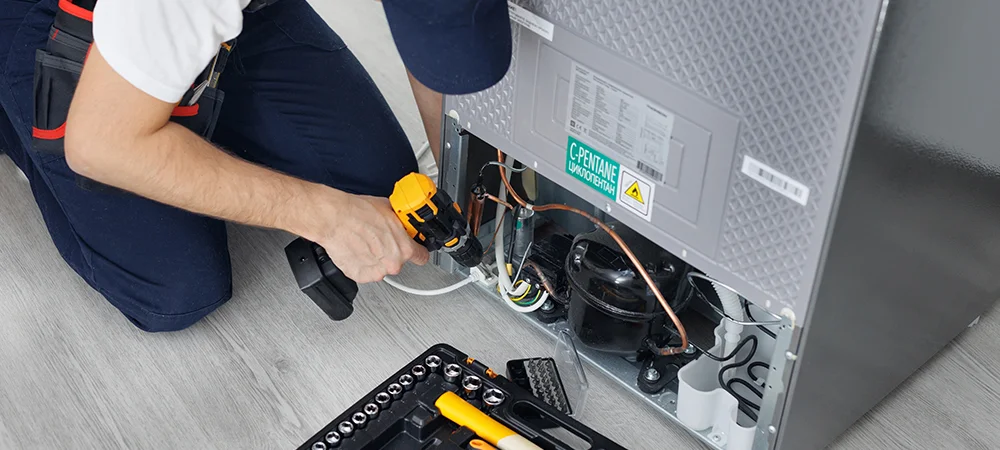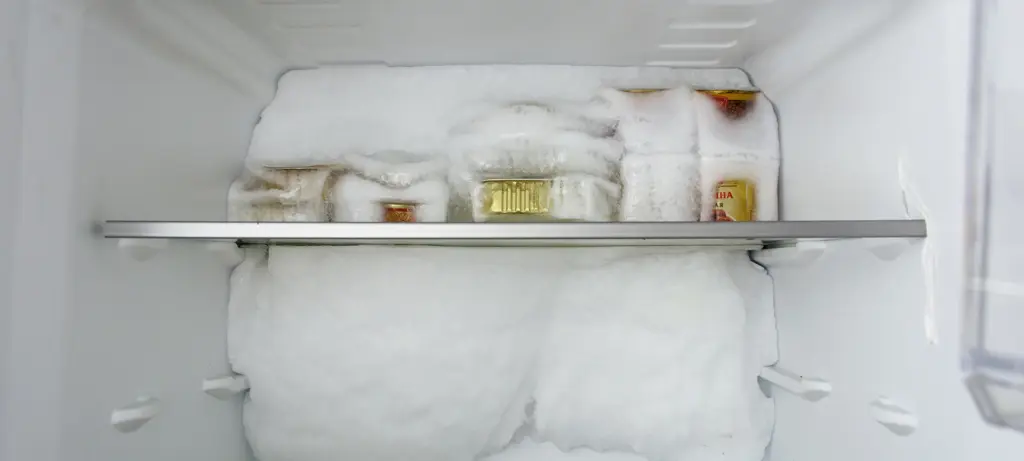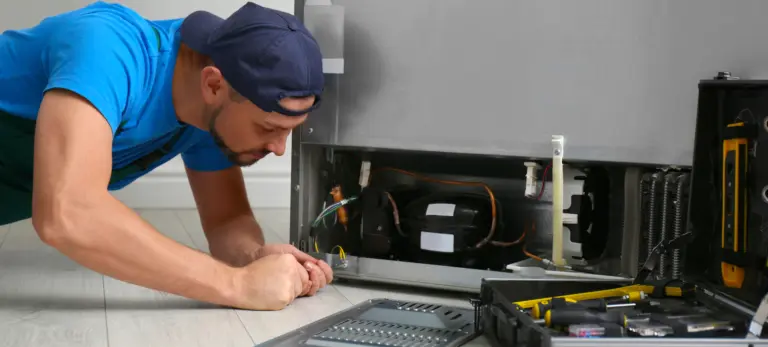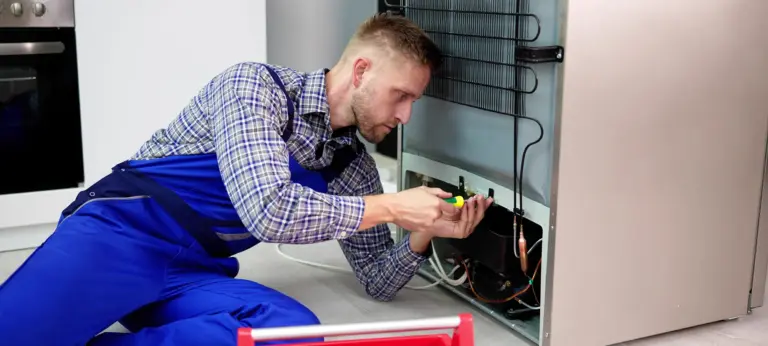If your refrigerator is not cooling properly, it can quickly turn your kitchen into a food spoilage zone, leading to wasted groceries and higher bills. Appliance Forever is here to help you understand why your fridge might be struggling to keep things cold and what you can do to get it back to optimal performance.
1. Check and Adjust Temperature Settings
One of the simplest causes of a fridge not cooling is incorrect temperature settings. Many refrigerators have separate temperature controls for the fridge compartment and the freezer. The ideal temperature for the fridge is between 3°C and 4°C (37°F to 40°F), while the freezer should be set at around -18°C (0°F).
Sometimes, the thermostat can be accidentally bumped or reset, especially if your fridge has a digital control panel or a dial that’s easy to turn. Double-check your refrigerator’s thermostat or temperature control settings to ensure they are set properly. Keep in mind that after adjusting, it may take up to 24 hours for the temperature to stabilize.
2. Ensure Proper Air Circulation by Unblocking Air Vents
Cold air circulation is essential for even cooling throughout your fridge and freezer. Most refrigerators have air vents inside that allow cold air to flow between compartments. If these vents are blocked by food items, containers, or ice buildup, cool air can’t circulate properly, causing uneven cooling or warm spots.
To fix this, reorganize your fridge to keep air vents clear and avoid overpacking. Avoid placing large items directly in front of vents, and periodically check for frost or ice buildup that may be obstructing airflow. Proper air circulation helps maintain a consistent internal temperature and prevents food spoilage.
3. Clean Dirty Condenser Coils to Improve Cooling Efficiency
Condenser coils play a crucial role in your refrigerator’s cooling system. Located at the back or underneath the fridge, these coils release heat extracted from inside the appliance. Over time, dust, pet hair, and debris can accumulate on the coils, causing them to work less efficiently.
Dirty condenser coils force the refrigerator compressor to work harder, which can reduce cooling performance and increase energy consumption. It’s recommended to clean the coils every 6 to 12 months using a vacuum cleaner with a brush attachment or a coil cleaning brush. Always unplug your fridge before cleaning to ensure safety.
4. Inspect and Replace Faulty Door Gaskets
The door gasket is the rubber seal that lines the perimeter of your refrigerator door. Its job is to keep cold air inside and prevent warm air from leaking in. Over time, these gaskets can become dirty, cracked, or warped, reducing their effectiveness.
To check if your door seals are working properly, close the door on a dollar bill or a piece of paper. If it slips out easily without resistance, the gasket may be worn and need replacement. Dirty gaskets can often be cleaned with warm, soapy water and a soft cloth. Replacing a faulty gasket can significantly improve your fridge’s ability to maintain the desired temperature setting.
5. Check for Frost or Ice Buildup on Evaporator Coils
Excessive frost buildup on the evaporator coils inside the freezer can block airflow and hinder cooling. The evaporator coils are responsible for absorbing heat from inside the fridge and freezer compartments. When they become covered in ice, the cold air circulation is restricted.
If you notice frost accumulation, it may be a sign of a defrost timer or defrost heater malfunction. Most modern refrigerators have an automatic defrost system, but when it fails, manual defrosting or professional repair may be necessary. Ice buildup can cause the fridge compartment temperature to rise, leading to spoiled food.
6. Listen for and Diagnose a Stuck or Broken Condenser Fan
The condenser fan helps cool the compressor and condenser coils, preventing overheating. If the fan is stuck or broken, the compressor may overheat and shut down, causing the refrigerator to stop cooling effectively.
You can usually hear the condenser fan running when the compressor is on. If the fan is silent or you hear your fridge making unusual noises like grinding or rattling, it may need cleaning, repair, or replacement. A stuck condenser fan is a common cause of a refrigerator not cooling and should be addressed promptly by a professional technician.
7. Examine the Evaporator Fan for Proper Functioning
The evaporator fan circulates cold air from the freezer to the refrigerator compartment. If this fan fails, the freezer may still be cold, but the fridge section will not cool properly.
A malfunctioning evaporator fan can be caused by a faulty motor, ice buildup, or electrical issues. If you notice that the freezer is cold but the fridge is warm, or you don’t hear the fan running when the door is open, it’s time to call a technician to inspect and repair the fan.
8. Verify Refrigerator Level and Door Alignment
An unlevel fridge can affect how well the doors seal and how the internal temperature is maintained. If the fridge is not perfectly level, the doors might not close tightly, allowing cold air to escape and warm air to enter.
Use a bubble or laser level to check the fridge’s position from side to side and front to back. Ideally, the fridge should be slightly tilted backward (about 1/4 inch) to help the doors close automatically. Adjust the levelling feet accordingly to ensure proper alignment and sealing.
9. Inspect the Power Source and Electrical Components
Sometimes the cause of a refrigerator not cooling is as simple as a loose power cord or a tripped circuit breaker. Double-check that your fridge is securely plugged into a working electrical outlet. If the interior light is off, or the fridge isn’t running at all, check your home’s breaker box to ensure the circuit hasn’t been tripped.
Faulty electrical components, such as the control board or thermostat, may also cause cooling issues. These require professional diagnosis and repair. If you suspect electrical problems, avoid attempting repairs yourself and contact Appliance Forever for expert assistance.
10. Monitor Food Storage and Avoid Overpacking
Overstuffing your refrigerator can block air vents and restrict proper airflow, leading to uneven cooling and warm spots. On the other hand, an almost empty fridge can also cause temperature fluctuations because the mass of food helps maintain stable temperatures.
Aim to keep your fridge about three-quarters full to balance airflow and thermal mass. Organize food items to prevent blocking vents and allow cool air to circulate freely. This simple step can improve cooling efficiency and help keep your fresh food safe longer.

When to Call a Professional Technician
If you’ve tried adjusting temperature settings, clearing air vents, cleaning condenser coils, inspecting door gaskets, and checking for frost buildup but your refrigerator is not cooling properly still, it’s time to call in the experts.
Issues like refrigerant leaks, compressor failure, faulty circuit boards, or broken fans require specialized tools and knowledge to diagnose and repair. Attempting to fix these complex problems without proper training can be dangerous and may cause further damage.
Appliance Forever’s certified technicians have the experience and equipment to quickly identify and fix your refrigerator’s cooling issues. Their professional repair services can save you time, money, and the hassle of spoiled food.
Frequently Asked Questions
What temperature should my refrigerator be set at for optimal cooling?
Keep your fridge between 3°C and 4°C (37°F to 40°F) and your freezer at around -18°C (0°F) for the best performance.
How often should I clean the condenser coils?
It’s best to clean the condenser coils every 6 to 12 months, or more frequently if you have pets or dusty conditions.
Why is my fridge cold but the freezer isn’t?
This could be due to a faulty evaporator fan, blocked air vents, or issues with the defrost system, which may require professional repair.
Can blocked air vents cause my refrigerator not to cool?
Yes, blocked vents restrict airflow and prevent cool air from circulating properly, leading to uneven temperatures.
How do I know if my refrigerator door seals are sealing properly?
You can test the door seal by closing the door on a dollar bill; if the bill slides out easily, the seal may be worn and need replacement.
Can I fix the refrigerator cooling issue myself?
Many common refrigerator cooling problems can be addressed with some basic DIY effort and a bit of elbow grease. However, more complex issues like refrigerant leaks, faulty compressors, or broken fans require professional diagnosis and repair to ensure safety and proper functioning. Always refer to your refrigerator’s owner’s manual for guidance, and when in doubt, don’t hesitate to call a qualified technician.
Keep Your Refrigerator Running Smoothly with Appliance Forever
A refrigerator that isn’t cooling can disrupt your daily routine and lead to costly food waste. Regular maintenance, like adjusting the refrigerator’s temperature controls, keeping air vents clear, and cleaning condenser coils, can prevent many common issues. But when problems persist, don’t hesitate to call Appliance Forever. Their professional repair services will help restore your fridge’s performance and extend its lifespan. Contact Appliance Forever today and keep your kitchen running cool and efficiently.








